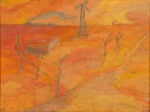Milano Chow – Sightlines

La galleria Acappella è lieta di annunciare l’inaugurazione della mostra ”Sightlines” di Milano Chow in conclusione del periodo di residenza presso lo Spazio Artisti di Pozzuoli, Napoli.
Comunicato stampa
La galleria Acappella è lieta di annunciare l'inaugurazione della mostra ''Sightlines'' di Milano Chow in conclusione del periodo di residenza presso lo Spazio Artisti di Pozzuoli, Napoli.
Nel lavoro di Milano Chow la costruzione simultanea tra interni ed esterni mette in scena il collasso tra pubblico e privato attraverso rappresentazioni della figura umana e di oggetti quotidiani. Sono delle finestre a fare da cornice ai soggetti raffigurati indirizzando il nostro sguardo verso questi. Il nostro punto di vista si inverte quando sono le figure stesse ad osservarci. Le inquadrature sono in parte o interamente filtrate da tende e oscuranti, generando un effetto teatrale che posiziona lo spettatore tra il pubblico e suggerisce ‘tutto il mondo è un palcoscenico, e tutti gli uomini e le donne sono semplici attori ’. Quando Chow ci conduce all'interno delle sue opere, la personificazione degli oggetti e le porte aperte appaiono come indizi che tracciano l'esistenza di chi vi risiede. L'architettura con i suoi oggetti diventa un meccanismo di visualizzazione che da vita ai protagonisti dei disegni, il più delle volte donne, misteriose e desiderabili dalla corporatura elegante in sintonia con i motivi classici degli esterni. Di queste non si conosce esattamente la storia, vengono raffigurate in solitudine e senza una vita familiare. L'abbigliamento spesso androgino di blazer e pantaloni si integra ed allo stesso tempo si contrappone agli esterni rievocando l'elogio di Le Corbusier alla moda femminile che più di tutte ha subìto il cambiamento dei tempi moderni. Nei disegni di Chow le figure dominano gli interni e occupano le pareti fino a restarne intrappolate, il nostro sguardo resta il solo in grado di liberarle.
---
The truth is that the interior and exterior are constructed simultaneously and inside and outside cannot be easily separated. With careful attention, Milano Chow renders this collapse between private and public through representations of the human figure and everyday objects. Windows frame the occupant and draw our eyes toward the subject or objects contained within the interior. When the occupant looks outward, the subject and object of the gaze are reversed. Openings are semi- or fully screened by curtains and blinds, generating a theatrical effect that suggests ‘all the world’s a stage, and all the men and women merely players’, and positions the viewer among the audience. When Chow brings us to the interior, the personification of objects and open doors appear as clues that trace the occupant’s existence. The architecture and objects become a viewing mechanism that produces the subject. The subjects in these drawings are women, mysterious and desirable. We don’t know her story but we see she is usually alone and without the presence of a family life. Our attention is drawn to her physique and elegance that resonates with the exterior classical motifs as well as her manner of dress, often an androgynous pairing of blazer and pants. Her attire worn on the interior both complements and resists the exterior and makes me recall Le Corbusier’s praise of women’s fashion (more so than men’s) because it has undergone the change of modern time. In Chow’s drawings the subjects and objects control the interior and occupy the wall, yet they are trapped within it, insisting that our gaze is the only thing capable of breaking down the wall.
- Meggie Kelley
Milano Chow (b. 1987) lives and works in Los Angeles. She received her BA from Barnard College and attended The Skowhegan School of Painting and Sculpture in 2013. Recent solo exhibitions include ‘Egg and Tongue,’ Mary Mary, Glasgow, ‘The Painted Screen,’ Chapter NY, New York, and ‘Mode Pratique,’ Young Art, Los Angeles. She will have a solo exhibition at Chapter NY in spring 2018. Her work is in the collection of The Whitney Museum of American Art.
*Lo stesso giorno inaugura Betty Danon "Geometrie anni Settanta" presso la Galleria Tiziana Di Caro.



